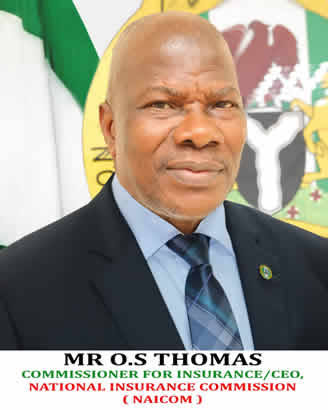Examining NAICOM’S Digital Transformation and Market Development Drives

Olorundare Sunday Thomas, NAICOM Boss
As the National Insurance Commission (NAICOM), the Nigerian Insurance industry regulator continues in it’s reforms and transformations aimed at positioning the industry to significantly contribute to the nation’s Gross Domestic Product (GDP) and for global competitiveness, EDET UDOH examines the progress so far made by the Commission in its Digital Transformation and Market Development Drives.
Digital Transformation is the adoption of digital technology to transform services through replacing manual processes with digital processes or replacing older digital technology with newer digital technology.
It is the integration of digital technology into all areas of a business, fundamentally changing how an organization operates and delivers value to its customers. It involves creativity, innovation and new ways of doing things or doing old things differently with the use of technology rather than enhancing and supporting traditional ways of doing things digitally.
NAICOM since the resumption of duty of the new Commissioner for Insurance, Olorundare Sunday Thomas, has been leveraging on technology and data for the transformation of its processes, drive its regulatory and supervisory functions, increase operational efficiency and improve its corporate outcomes.
NAICOM is undergoing transformation from the inside out and the target is to ultimately achieve an end to end automation of all its processes. Digital Transformation involves different thinking, presents new opportunities, encourages innovation, creates new business processes and models, improves customer experiences and shifts organizational culture.
According to expert, digital transformation marks a radical rethinking of how an organization uses technology, people and processes to fundamentally change business performance. The People, Process and Technology Framework is used for organizational transformation and management. To achieve organizational efficiency, there is need for a balance between the three and a good relationship maintained between them. The right people to be involved, right process defined and the right technology to handle the load. A balance of the three drives actions. The process is like a 3-legged stool, if one leg is out of balance, the stool wobbles.
The key elements of digital transformation, according to expert, include People, Process and Technology. People are the most important part of the triangle, without people nothing works (Who will use, experience, qualification, attitude, emotions, skills, politics,, buy in, change management, project champions).
Process: It is what we do in order to deliver the expected value to our stakeholder. A series of actions and steps that needs to happen in order to achieve a particular outcome/goal, processes are repeatable. They produce the same result every time, regardless of who is carrying them out.
People are ineffective without processes in place to support their decisions. When organizations restructure, technology changes and processes need to be re-imagined, improved or completely change in order to continue providing value.
Technology: Technology exists to provide value to people. The technology must fit the organization and its changing needs. Technology alone does not solve all problems unless there are people and processes to support it.
On the other hand, market development and restructuring represent a transition from the prior structural combination of programmes and markets to a new structure that must enable greater profitability and effectiveness of operations. If the market restructuring is one of the most important restructuring area in the company in times of crisis it should be based upon marketing concept in order to follow the right direction of the renewal.
Therefore, The National Insurance Commission (NAICOM) in line with its reforms, in 2009, launched the Market Development and Restructuring Initiative (MDRI) as a vehicle to, amongst others, drive enforcement of compulsory insurances, reduce incidences of fake insurance and in the process as well as ensure the growth of the industry.
Speaking on “NAICOM’S Digital Transformation of Systems And Processes: Progress So Far” at the just concluded 2021 seminar organized by NAICOM for insurance journalist in Lagos, Deputy Director, Information and Technology (IT), Mr. Abiodun Aribike, harped on the progress so far made on the digital transformation of the Commission seven years after the commencement of the transformation process.
It should be recalled that the Commission during the 2020 edition of the seminar at Uyo, Akwa Ibom State, said it has successfully put in place a real-time digital platform that will drive activities in the insurance sector.
According to the commission, the portal, which was in the works for six years, was finally concluded recently as part of ongoing reforms by the current management of the commission. It said the new portal is such that wherever anybody is in the world needs information on the nation’s insurance sector, it would be available to him at the click of a button.
According to the Commissioner, “We will be looking at the digital world. Part of what we have done so far is the fact that our portal that was on the drawing board for over six years has been fixed. It is taking us from where we are to the next level.
“We have sensitised the technical people in the industry and they have been going through series of trainings.
“The next thing we are going to do is to engage the industry with IT guidelines. It is no longer going to be historical reporting,” Thomas said.
While giving insight on the Commission’s digital transformations of systems and processes so far, Aribike highlighted the following issues: The 4 Pillars of Digital transformation; The drivers of Digital Transformation; IT Infrastructure; Software and Applications; ICT Policy for Insurance Industry and The benefits of Digital Transformation.
4 Pillars Of Digital Transformation
The four pillars of digital transformation, according to Aribike takes into considerations Stakeholders’ engagement (improve experiences, Increase stakeholder satisfaction; Employees’ empowerment (innovate, automate, data driven culture, working tools, developing new skills, Productivity tools); Optimize Operations Optimization (automate, improve, optimize) and Transformation of Service offerings ( innovate, new business models).
The Drivers Of Digital Transformation In NAICOM
Aribike identified Management’s Vision for regulatory effectiveness and transformation of work processes; the impact of volatility, Uncertainty, Complexity, Ambiguity (VUCA) on Insurance; the need to change, innovate, improve and adapt as a regulator to present realities as the drivers of digital transformation in NAICOM.
Others, according to him include, evolving and changing stakeholders needs and preferences; rapid advances in information technology and emerging technologies; increasing data volumes and need to aggregate data spread across different desktop, laptops and files to one central location; market development and growth opportunities; changing Demographics of the Commission’s workforce; the need for accurate statistics in the industry and eliminating incidences of fake Insurance.
Information Technology Infrastructure
While giving insight on the information and technology infrastructure of the Commission, Aribike explained the workings of Datacenter, Local Area Network (LAN), Wide Area Network (WAN), IP PBX Telephony, Servers, Storage and Virtual Provisioning Service and End User Infrastructure.
Datacenter: A refresh of the datacenter was carried out due to obsolesce of some equipment like the Datacenter Monitoring system. Redundancy was made available for all Power and cooling equipment.
Local Area Network (LAN): A local area network (LAN) is a Computer Network that interconnects computers in a limited area such as a home, school, computer laboratory, or office building using network media.
The IT Unit manages a local Area network (LAN) with fibre Optic Back Bone for computers with structured cabling to cater for all offices within the headquarters. This over 200 dual node LAN distributed across the entire floors of the building provide reliable and qualitative bandwidth that guarantee smooth and uninterrupted data transmission across the network. A number of fault tolerance features were incorporated into the LAN for reliability and minimal network downtime.
The LAN provide Resource and file sharing capabilities for our servers, storage, desktops, printers thereby reducing hardware expenses, improving productivity and allowing multi user access to user applications. It also provides a centralized security control for access to the network and its resources.

Head, Corporate Communications & Market Development, ‘Rasaaq ‘Salami
Wide Area Network (WAN): Contract for implementing Wide Area Network (WAN) has been awarded to Galaxy Backbone and the project is ongoing. This will connect the NAICOM’s Head Office to the Zonal offices. The interconnectivity will enable the staff of the zonal offices enjoy all the IT services currently operational in the Head Office.
It enables consolidation of resources in one central data centre rather than having distributed data in all our remote office location. It Shares software, applications and resources with the connecting locations and also ensures the reduction in IT support cost while data security and protection becomes much easier.
IP PBX Telephony: The commission has in operations an IP (Internet Protocol) PBX (Private Branch Exchange) business telephone system designed to deliver voice and video over our local area network and capability to interoperate with Public Switched Telephone Network. (PSTN) The system is presently used for voice calls all over the Head office in Abuja. The zonal offices will be using the system via the Wide Area Network (WAN)
Servers, Storage and Virtual Provisioning Service: We have commenced a refresh of Servers in the Datacenter. New servers are being procured and old ones are upgraded or repurposed for other uses. The Commission also enjoy Virtual Provisioning Service (VPS) Servers with Galaxy Backbone Ltd. This provides for high availability and redundancy. We have an SLA of 99.9% availability of services with them.
End User Infrastructure: Continuous procurement of Desktops, Laptops, Printers, and Scanners. All operating systems, office productivity tools, antivirus and software have been upgraded to current editions or versions.
On Messaging Platform (E-Mail), he said “the Commission presently uses Microsoft Exchange, an Enterprise Email Service for communications in the commission. It provides tools for email, calendaring, file sharing and supporting collaborative work. These resources can be accessed via desktop clients, mobile devices and web clients. The e-mail is based on the .gov.ng platform. The solution is in operations and it is currently been used by all staff of the Commission. It has helped with Real Time Communications, Task Management (to do list, track progress, instant notification etc), Eliminate unproductive meeting time, improved File Storage and Sharing, Increased Efficiency, Performance Tracking and ensure Easier Project Management.”
On Zoom Collaboration, according Aribike,” the Commission has procured an on premise ZOOM Collaboration Solution. It is used for video conferencing, web conferencing, webinars, meeting, chats, calls etc. The Commission has successfully used the solution for meetings with stakeholders, induction, trainings, strategic retreats etc. This has been successfully integrated with our messaging platform.”
On Enterprise Resource Planning Software, Aribike explained that “the Commission has upgraded the Enterprise Resources Planning (ERP) Software which automate the processes of the Finance and Administration division. An Enterprise resource planning (ERP) is business management software that allows an organization to use a system of integrated applications to manage its business.
The Finance and Account Directorate currently uses Microsoft Dynamics NAV, an Enterprise Resource Planning (ERP) Application which is International Financial Reporting Standard (IFRS) Compliant to computerize its General Ledger, Chart of Accounts, Accounts Payable, Accounts Receivables, Fixed Assets, Bank Reconciliation, Funds Management, Budgeting, Cash Management, Journals, inventory management etc. The Finance and Account module is fully functional and in use by the Directorate.
“The Microsoft Dynamics NAV software has been upgraded from 2012 to 2019 edition to accommodate and automate the processes of the Admin and HR Directorate and Procurement. The solution which has a self-service also automated the following processes: Recruitment/Hiring/Selection, Personnel Records Management, Position management, Performance Management, Promotions, Time and Attendance, Leave, Medicals, Transfer, Payroll, Compensation/Benefit Management, Exit Management, Loan Management, Disciplinary, Career Management, Training and Development, Procurement, debit notes
“It also provides dashboard for reporting, analytics and management decision making.
“Apart from automating the processes of the Finance and Administration division, the ERP has provided the following benefits: Total Visibility of the business, Provides Real Time Information and Data Standardized business processes, Improved reporting and planning, Increased Efficiency, Increased Productivity, Improved Customer Service, Improved Collaboration and Workflows, Data Security and Quality,” Deputy Director, IT said.

Deputy Director IT, Abiodun Aribike
Speaking on Electronic Document Management System, he posited that “the Commission is developing an Electronic Document Management System to store and manage electronic documents and keep images of paper documents in a secure location. The Solution was built using Microsoft SharePoint and it is currently undergoing a User Acceptance Test (UAT).
“It has a workflow system built into it. This software will help the Commission control and manage access to important official documents, maintain restricted access to confidential documents, reduces the time and efforts taken to locate documents, reduce loss of documents and provide safe storage and backup of all documents in a secure location or library.”
On the NAICOM Portal, Aribike said, “In line with the commitment of the National Insurance Commission (NAICOM) of using information technology to drive the supervision, regulation and governance of insurance business in Nigeria, it has developed the NAICOM Portal to provide a direct interface with the industry to ensure greater accountability and transparency.
“The NAICOM Portal is a digital platform that is designed to drive the core business processes of the Nigeria Insurance industry with the attendance benefits of service efficiency with quick turnaround time, eradication of fake insurance policies, improve public trust and confidence in insurance.
“Deepen insurance penetration; provide access to statistical data of the insurance industry, streamlined approval processes for registration and renewal of licenses etc. The digital platform will provide a single point of contact between NAICOM and the insurance industry. The NAICOM Portal comprises of the insurance policy system, the licensing system and the regulatory and financial returns system.”
He said while the Insurance Policy System captures all insurance policies issued in Nigeria, the Licensing System automates the core business processes of registration/renewal of licenses, new product, AIP & Attestation Approvals.
The Regulatory and Financial Returns System, Aribike hinted, are still at the Conception Phase.
The Insurance Policy System (The Licensing System; Regulatory and Financial Returns System Contact Center), he explained, “is a digital platform that has been designed to capture all insurance policies issued in Nigeria with a unique identifier.
The portal generates a unique identifier for every policy issued by insurance companies and enable insurance customers and third party entities such as Law Enforcement Agencies to query and validate their insurance policies.
“Most importantly, it provides NAICOM a platform for interconnecting all industry stakeholders to support real time aggregation of data on policies at the time of underwriting and policy issuance.
“It is a digital platform that essentially captures all insurance policies issued in Nigeria; generates a unique policy identification number for all issued policies necessary to ensure fidelity and validity of all policies in the country; Obtains and manages information on all insurance policies, and premiums sold by insurers, brokers and agents.
“It provides information on policies to members of the public and provides management information to NAICOM regarding summary and/or details of all policies by company, broker, and agents, ensures proper accountability of all premium returns by insurance companies; captures all businesses done by every broker through the underwriter; ensures proper accountability of all insurance levies received from brokers.
“It provides easy access to data regarding policies issued, to support analysis and policy based decision making, provide a means for members of the public to validate the Insurance Policy issued by the appropriate Insurance stakeholder, allow Law Enforcement personnel to verify any insurance instrument tendered to them in the course of performing their function; enables NAICOM to monitor the claims payment process.”
Functions of the Portal
Aribike said the portal will take care of the activities of insurance companies including all intermediaries –Brokers, Agents, Loss Adjusters as well as Law Enforcement Agents, and the general public, thus: Insurance Company: Records policies; Generates unique policy ID; Prints proof card (with policy unique ID) for a recorded policy; View/modify/search insurance policies; Terminates/renews/coinsures a recorded policy; Records notified claims and settlement; Authorizes/un-authorizes agent.
Broker: Views recorded policy; Prints proof card (with policy unique ID) for a recorded policy; Searchs/Views recorded coinsure policy; Views recorded claims
Agent: Views recorded policies; Prints proof card (with policy unique ID) for a recorded policy; Searches a recorded policy; Views recorded claims for a recorded policy
Loss Adjuster: Searches a policy by unique policy ID; Accesses an assigned claim; Views accessed & assessed claims; Inputs assessment information
Law Enforcement: Searches a policy by unique policy ID; Searches a policy by a keyword
Public: Validates a policy by unique policy ID
Insurance Policy Recording: The Three (3) basic ways for recording Insurance Policy on the NAICOM Portal are as follows: Records a Single Policy; Records Policies in Bulk; Records Policy through Web-Service/API. 1 & 2 has been disabled, policies are only uploaded via APIs.
Mobile Apps: Two platform supported iOS (Apple) and Android (Google); the two version generated Public version and Law enforcement version.
Licensing System: The manual system of processing applications required that applicants physically drop off their applications at the Commission while waiting for approval as the manual processing takes place.
Challenges with this manual system includes: Delays in application movement within NAICOM; longer processing times; lost manpower hours due to back-and-forth in application processing; little communication about application status.
The Licensing system automates the core business processes at NAICOM involving registration & renewal of licenses, approval for new product, approval in principle and attestation approvals.
According to Aribike, “All of these processes will proceed in the portal environment from the application stage where all supporting documents are provided, to the review phase, the approval phase and license generation where applicable.
“There are other administrative functionalities that facilitate those primary functions, including registering an account for secure access; maintaining profiles on the system; downloading application documents; completing the application forms; attaching supporting documents; checking the status of their application as it goes through the approval stages; accessing information regarding license applications or other principal functions through the system and Certificates approval and Printing. These services are provided to individual stakeholders based on their profiles.
“Going forward, the Licensing System provides the following benefits: Secured personal accounts; submission of applications and supporting documents in real-time; applicants account is updated with the status of the application as it progresses; Real-time communication between NAICOM and applicant and Faster processing times with process efficiency.
The Licensing System, according to him, takes care of core processes automation such as new agent registration; agent license renewal; new broker registration; broker license renewal; new loss adjuster registration; loss adjuster license renewal; new insurance company registration; new micro-insurance company registration and new takaful company registration.
Others he said are: insurance company AIP; insurance company attestation; insurance company new product; takaful new product; Letter of No Objection; Certificate for Off-Shore Re-insurance and Letter of Attestation for Treaty Remittance.
Regulatory and Financial Return System, Aribike stated, “is currently going through tender phase, provides the platform for the submission of all Insurance industry regulatory returns and compliance electronically. The Financial Analysis module of it aims to automate financial analysis, credit control functions, computation of levies, and provide adequate and timely information to support management decision making.
“The system will provide a database which will serve as a central repository for current and historical financial information about the Insurers, Re-insurer, Brokers and Loss Adjusters for regulatory purposes and general information dissemination.
“Returns Portal ensures online Submission of Returns; Financial Analysis (Key Financial Ratio and Indicators, Trend Analysis, Time Series Analysis and Risk Ratios and Ratings); Fee, Levy and Penalty Management; Dashboards for management and Repository to safely and securely store all data related to insurance companies and brokers.
On Complaints Management System, the IT expert said “NAICOM is also about to procure a Complaints Management System that will serve as a platform to manage end to end complaints process. This will help in handling, managing, responding to, and reporting to stakeholder complaints. The Software will also help streamline the approach and provide constant monitoring to ensure faster resolutions. This will enhance stakeholders’ satisfaction, increase claims payment and deepen the Insurance penetration.
“It will ensure reduction in service cycle time; management and users won’t lose sight of complaints; tracks who is working on a complaints and when it will be completed; ensures all required task are completed for each complaints and Helps users process complaints easily.”
ICT Policy For Insurance Industry
Aribike said NAICOM in its efforts at enhancing the competitiveness of the sector, that it is essential the industry delivers services in ways that brings benefits to consumers of insurance services, adding that the Commission is facilitating the standard of ICT infrastructure to support the security and safety of Insurance operations and data management.
“NAICOM has released an ICT guideline to be used as a minimum standard for the computerization of operations in the insurance sector. The guidelines will form part of future requirements for conducting insurance business in Nigeria.
“Some of the objectives of the Nigeria Insurance Industry ICT Guideline are as follows: establish a minimum baseline for insurance policy data management practices within the industry; Aid the establishment of inter-operable ICT systems for easy exchange of data between the commission and insurance companies; Improve connectivity and establish secured environment for data processing; Increase transparency and operational performance in insurance policy underwriting processes in Nigeria,”
Others, he said are to facilitate the establishment of standard for the conduct of insurance business in Nigeria; ensure all stakeholders meet the target requirements for submission of necessary reports to the Commission; ensure compliance to statutory reporting requirements from NAICOM and other agencies of government.
The Policy, according to him, covers Data Communication Infrastructure, Network Operation Centre, Common Network Services, E-mail Services, Websites, Call Centre and Customer Helpdesk, Management of Data, Data Security and Protection, Financial Information Management System, Insurance Policy Administration and Claims Management System, Electronic Document Management System, ICT Management and Business Continuity and Disaster Recovery.
The Benefits Of Digital Transformation
Aribike enumerated the benefits of digital transformation to include, enhanced stakeholder experience and satisfaction; increased revenue, reduced cost and blockage of leakages; improved productivity; increased efficiency in service delivery; enhanced data collection and analysis; data driven insight and decision making; increased agility and innovation and improved resource management.
Market Development Drives
In his presentation at the event entitled “Market Development Drives of NAICOM: Initiatives And Prospects” Head, Corporate Communications & Market Development, ‘Rasaaq ‘Salami, informed the gathering on what the Commission has done so far in this area, the prospects and it’s plans going forward.
He said the nation’s insurance industry has done well with it’s progress so far adding that that 42 million Nigerians have so far been insured as of December 2020.
Salami who was elated by the progress of the insurance industry coupled with the leadership style of the Commissioner for Insurance, Mr. Sunday Thomas, reel out some achievements recorded so far.
Market Development and Restructuring Initiative (MDRI)
The Market Development and Restructuring Initiative (MDRI) is a regulator-led market development Plan to expand the width and depth of Nigeria’s insurance market, launched in 2011 (shifted from the initial launch date of 2009).
According industry analysts, the market development initiative clearly is within the mandate of an industry regulator in a developing country like Nigeria, given the many market imperfections that are prominent in developing country economies.
The aims and objectives of MDRI, analysts believe, seems to be both a medium-term Vision Statement and Strategic Roadmap for the industry.
Though NAICOM is working assiduously on the digitalization of the industry’s processes and operations, yet a lot still need to be done. For instance, check done on the NAICOM website for the MDRI document, showed that the MDRI document meant to guide insurance industry growth and development was not available on NAICOM’s website since 2019. Same can be said of other vital documents that officially supposed to be on the Commission’s website for easy accessibility.
On what the Commission has done in terms of laying of foundation, Rasaaq said it Market Development and Restructuring Initiative (MDRI) was launched in 2009 as a vehicle to, amongst others, drive enforcement of compulsory insurances, reduce incidences of fake insurance and in the process ensures the growth of the industry.
He said the industry is growing, that the approximately 800,000 Nigerians insured in 2010 and that today the number has grown to 24 million in 2016 and 42 million by 2020 while focusing on achieving N1 trillion Gross Written Premium.
He went further to say that policies held by individual Nigerians stood at 1,034,383; Corporate & Non-Individual policies has reached 891, 128; he put the total policies written at 1,925,511; Penetration as at December 2020 at 0.72% (About 1%) while the Gross Written Premium by 2020 hit N520 billion
Salami said that NAICOM’s market development initiatives have indeed been very successful, stating that the regulators were pursuing compulsory microinsurance and Takaful, with vigour.
He said the Commission would do more to promote Micro-Insurance and Takaful while enforcing Compulsory insurances across the States in Nigeria.
Above all, Salami said, going forward, the builders liability insurances; Group Life Insurance; Healthcare Professional Indemnity Insurance; Occupiers Liability Insurance; and Motor Third party Liability Insurance would receive fresh push.
Industry’s analysts are not happy that a document supposedly agreed as a guide to action is not available for public/industry consumption on the insurance regulator’s website.
Really this is a concern for me. If there is a document that is meant to guide thought and action in the industry (a Strategic Plan) how come the document is not freely and readily available? It is like the Economic Recovery and Growth Plan (ERGP) not being readily available to State Governments, Chambers of Commerce and Industry, large industrialists like the Dangote Group, universities, and other academic institutions, etc!
This, according to them suggest that there is no ownership of MDRI, in the sense of the regulator who spearheaded its preparation taking charge vigorously of its implementation, and of the operators having a buy-in into the motivation for, preparation of, and the actualization of the Plan.
Way forward
Speaking in an interview on how the industry can go about updating MDRI, or crafting a new Vision and Strategy for Nigeria’s insurance industry, Tunji Oluyemi, Managing Director/ CEO, Tespauruth Consulting Limited (TCL), called for consultations among all the arms of the industry.
According to him, we need to consider first of all some foundational matters that give support and effect to any Plan.
First, there must be very wide consultation among all the arms of the industry. Whatever the forms the consultation may take, it is important to seek out the problems of the industry, especially to ascertain the root causes of the seeming industry stagnation, as well as suggestions relating to growth and supervision of the industry. This is what will ultimately ensure that there is ownership of the outcome of deliberations. In particular, the opinions and concerns of the market makers in each arm of the industry must consciously be courted as they, because of their size and clout, can make or mar the implementation process.
“The opinions and position paper(s) of NAICOM will, of course, carry much weight. A Vision/Strategy Paper cannot and must not be something exclusively written up on the laptop of a consultant, to the exclusion of the industry it is meant to serve, and then introduced to the operators after it is written up. That would be, from the onset, a guarantee that there would be no ownership of the Plan, from the industry arms.
“Secondly, in the course of writing up the document, there will be a necessity for a back-and-forth interactive process of consultation among the parties, clarifying all grey areas, or areas on which there is less than full agreement by all parties.
And then, there must of necessity be a Standing Committee drawn from all arms of the industry to carry on a comprehensive review of implementation, during the life of the Plan. But from what I said earlier, it is clear that my preference is for the crafting of a new document. It seems MDRI is a tired document, indeed, one that has hardly been implemented, or implemented with the required vigour,” he added.





